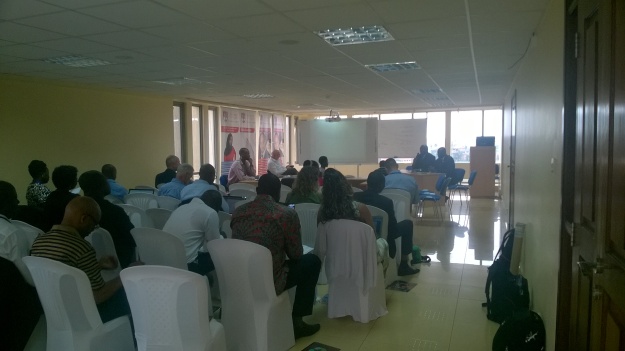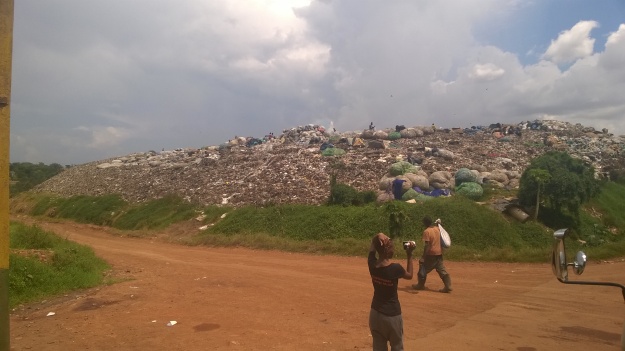Xavier Lemaire from UCL and Simon Bawakyillenuo & Innocent Agbelie from the University of Ghana ISSER recently collaborated on this post for the UrbanAfrica.net website. The original post can be found at: http://www.urbanafrica.net/urban-voices/waste-to-energy-african-cities-can-transform-their-energy-landscapes/, reproduced in full below.
The critical issue of waste management
Waste management is a critical issue for most African cities as a result of the huge generation of mountains of waste stemming from increases in urban populations over the last few decades, coupled with access to consumer goods by a fast-growing middle class. And waste generation is expected to increase rapidly in the future. City authorities are therefore faced with the challenge of managing urban waste with limited resources at their disposal.
The extent of this challenge is made clear by an Africa Review Report on Waste Management in African cities, which notes that less than half of waste is being collected, the rest being dumped in the urban landscape [1]. Accra alone generates approximately 1000 tonnes of waste per day at an annual generation rate of 3.7×104 Tons/year while the existing collection capacity can only keep up with about 55% of this amount (Fobil (2000). This means that an excess of 1.7×104 Tons/year is left to accumulate in the core areas of the city for several months [2]. In the wake of this finding, Obour (2012) described the city of Accra as almost engulfed in filth [3].
Unsustainable waste management has adverse consequences on the environment including the breeding of mosquito and related diseases, emission of obnoxious odours and methane, and flooding through choked drainage systems [4]. These waste-related problems are not uncommon in most African cities and city authorities are seeking sustainable waste-management solutions. Indeed, unraveling sustainable solutions for efficient waste management is one of the top priorities of the two municipalities in Ghana that are partners to the “Supporting Sub-Saharan Africa’s Municipalities with Sustainable Energy Transitions (SAMSET)” project.
Sustainable waste management practices
The most sustainable waste management practices are waste reduction and waste recycling as shown in Figure 1 below.
Figure 1: Hierarchy of sustainable waste management

Source: Adapted from Rodriguez, 2011.
Effective waste recycling ultimately leads to waste reduction. It is possible to recycle completely a waste product only when the production and marketing processes themselves have integrated the target of 100% recycling as the ultimate goal of the design of the value chain, making it possible to generate money from the recycling activity itself (and allowing the recycling activity not just being an end of chain cost).
In most African cities, little is done and far little is happening currently in the areas of waste reduction and waste recycling as waste management practices. Sadly, waste management practices in Africa can be placed in the first and second rungs from the bottom of the hierarchy of sustainable waste management (Figure 1). It has to be noted that, another waste management practice that is common in African cities is composting, that is, turning the by-products of organic waste into manure for agricultural activities. Most companies that have taken such initiatives have quit in many countries due to low patronage of such compost products. It is, however, flourishing in other countries such as Uganda and parts of South Africa, like Cape Town.
Opportunities and potentials for waste-to-energy in African Cities
Using waste to create energy is a viable option for most African cities. Waste can be incinerated to produce heat or electricity; and methane can be collected from landfills and be used to, again, generate heat or electricity.
There is high level of organic content of waste generated in most African cities. In Ghana, for example, about 66% of the total waste generated is organic, as shown in Figure 2 below.
Figure 2: Waste type and composition in Ghana

Source: Zoomlion Ghana Limited (2013).
Any organic waste from urban and rural areas as well as industries is a resource due to its ability to degrade and release methane, which can be used for energy generation. The problems caused by solid and liquid wastes can be significantly mitigated through the adoption of environmentally-friendly waste-to-energy technologies that will allow treatment and processing of wastes before their disposal.
Waste-to-energy is a win-win endeavour. As a sustainable waste management system it produces energy that can be sold for economic gains for the producer. It also provides green jobs. While it is thought that such projects are highly technical and often require imported skilled labour and technology from developed countries, local people, especially “waste scavengers,” can be employed and use their skills. It seems unlikely that municipalities themselves or international corporations can deal with waste. Involving local entrepreneurs in the process is fundamental [5] and can be extended to entrepreneurs from informal settlements [6].
Most cities in Africa already use landfill waste disposal systems. City-owned vehicles, such as trucks, can be used for waste-to-energy projects to cut costs. The problem in most African cities, however, is waste sorting. Waste is often not sorted at the collection points hence all kinds of waste end up at the depositing site. Tying economic benefits to sorting of waste at the households level and effective education of the general public on the need for proper waste sorting can help the course of waste-to-energy in most African cities.
Prospects for waste-to-energy in Africa
All landfills generate methane, so there are many opportunities to reduce methane emissions by flaring or collecting methane for energy generation. As mentioned previously, there are two main technological options to transform waste into energy, both of which can be used to create heat or electricity: incineration or collection of methane. Often proposed by Western companies, the incineration technology can be quite costly to build, relies on imported technologies, and requires the collection of huge amount of waste from vast catchment areas. Huge catchments areas imply that there will be high costs related to logistics, while fleets of trucks could contribute to road congestion.
Production of energy from landfill requires certain technical skills, which can only be acquired through training and experience. Methane is a potent heat-trapping gas (more than 20 times stronger than carbon dioxide) and has a short atmospheric life (10 to 14 years) [7]. Therefore, reducing methane emissions from municipal solid waste landfills through a Landfill Gas project is one of the sustainable means to lessen the human impact on global climate change. In addition, a Landfill Gas project, during its operational lifetime, will capture an estimated 60 to 90 percent of the methane created by a landfill, depending on system design and effectiveness. The methane captured is converted to water and carbon dioxide when the gas is burned to produce electricity or heat.
Unfortunately, there is no one best technological fixed solution. Each municipality has to find a specific mix of options, combining the appropriate technologies with existing social agencies to be able to tackle progressively – after a series of trials, successes and errors – this problem. Indeed, there have been many trials and failed waste to energy projects in Africa. That notwithstanding, many opinion groups, private organisations, international organisations and governments in most African countries are still enthusiastic about sustainable waste management practices.
It is therefore imperative for city authorities to make strategic choices about the types of socio-technical solutions that can be implemented realistically, taking into account their financial and social long-term sustainability. This is to avoid repeats of failure of waste-to-energy projects funded by international organisations in Africa. Suffice to mention that waste management is a complex issue that must involve contributions from a variety of stakeholders from local communities to policy-makers including industries and farmers for success to prevail.
Key among the ways African cities can transform their energy landscape through waste-to-energy is political and institutional commitment. It is encouraging to note that in recent times a lot of governments in Africa are gradually embracing the Green Growth development pathway, with some having already mainstreamed Green Economy actions in their national development plans. These steps give signal great prospects for waste-to-energy development in Africa because Green Growth developmental actions entail foster economic, social and environmental development. Thus, in the not too distant future, it is envisaged that a wave of different waste-to-energy projects could spring up across African cities when emphasis is not only placed on the cost component of waste-to-energy, but both the environment and social benefits as well.
References
[1] Sixth Session of the Food Security and Sustainable Development. Africa Review Report on Waste Management – Main report, Addis Ababa, Ethiopia, 27-30 October 2009. http://www.uneca.org/publications/africa-review-report-waste-management-main-report
[2] Fobil, J. N. (2002). Proceedings of International Symposium on Environmental Pollution Control and Waste Management 7-10 January 2002, Tunis (EPCOWM’2002), p.193-205.
[3] Obour, S.K. (2012). “Accra Sinks under Filth”. The Mirror, Saturday, September 15, 2012, pp.24.
[4] Dr Simon Bawakyillenuo and Innocent Komla Agbelie, Waste as a Resource for Energy Generation in the Ga East and Awutu Senya East Municipalities: the Policy Discourse. University of Ghana, SAMSET project, 2014, http://samsetproject.site11.com/outputs/
[5] Un-Habitat, Note on Urbanisation Challenges, Waste Management, and Development, 12-14 February 2014, Mauritius. http://www.europarl.europa.eu/intcoop/acp/2014_mauritius/pdf/un_habitat_presentation_en.pdf
[6] Towards social inclusion and protection of informal waste pickers and recyclers – waste collection project proposal for and professional support provided to small entrepreneurs by the eThewini municipality. ENDA – IWPAR Best practices #9 www.iwpar.org
[7] Landfill Gas Energy Basics. Available at: http://www.epa.gov/methane/lmop/documents/pdfs/pdh_chapter1.pdf












